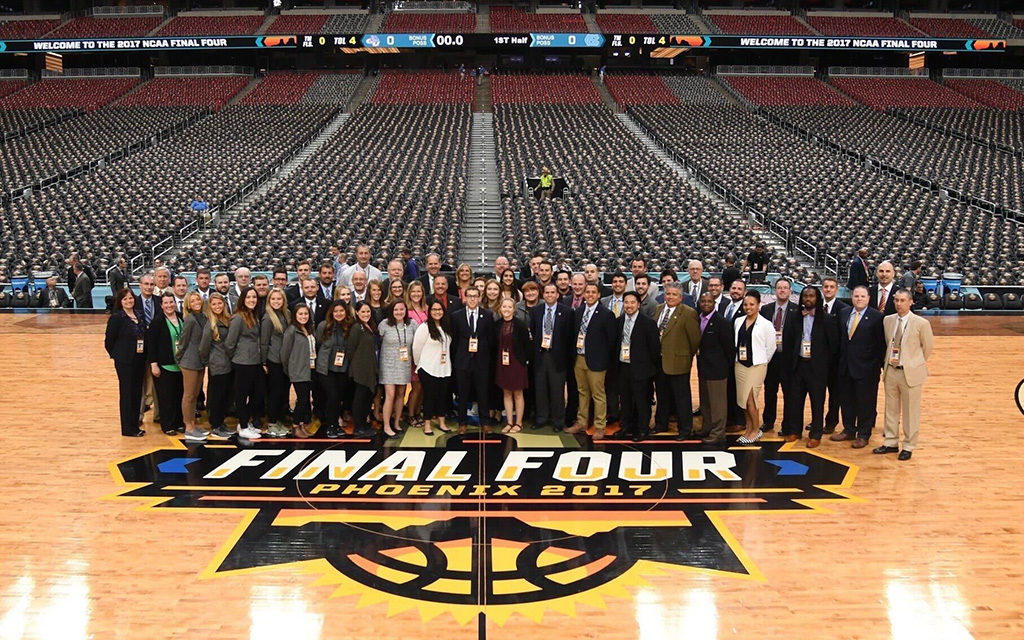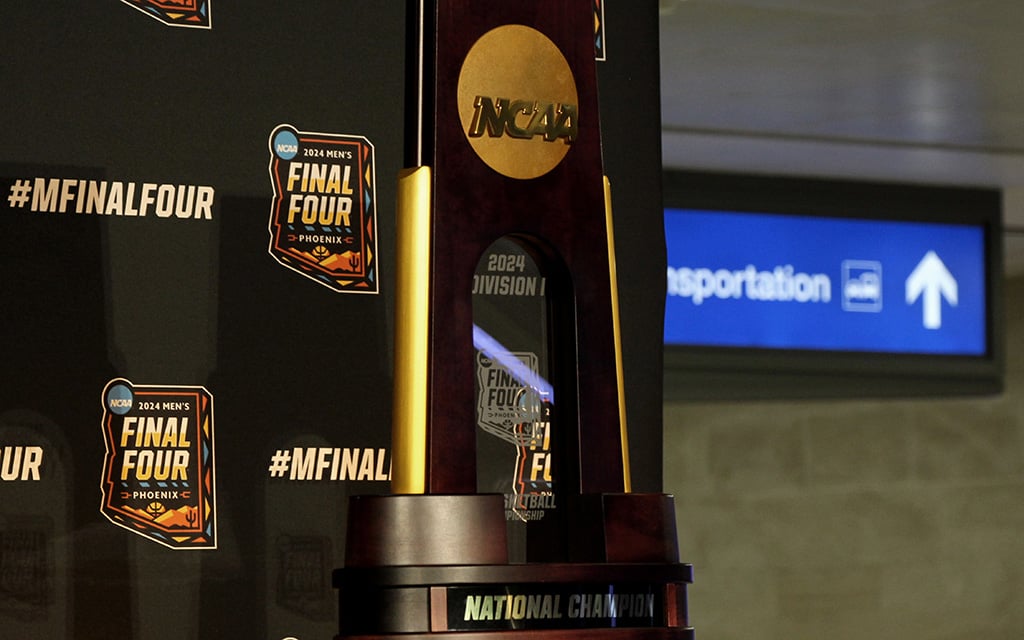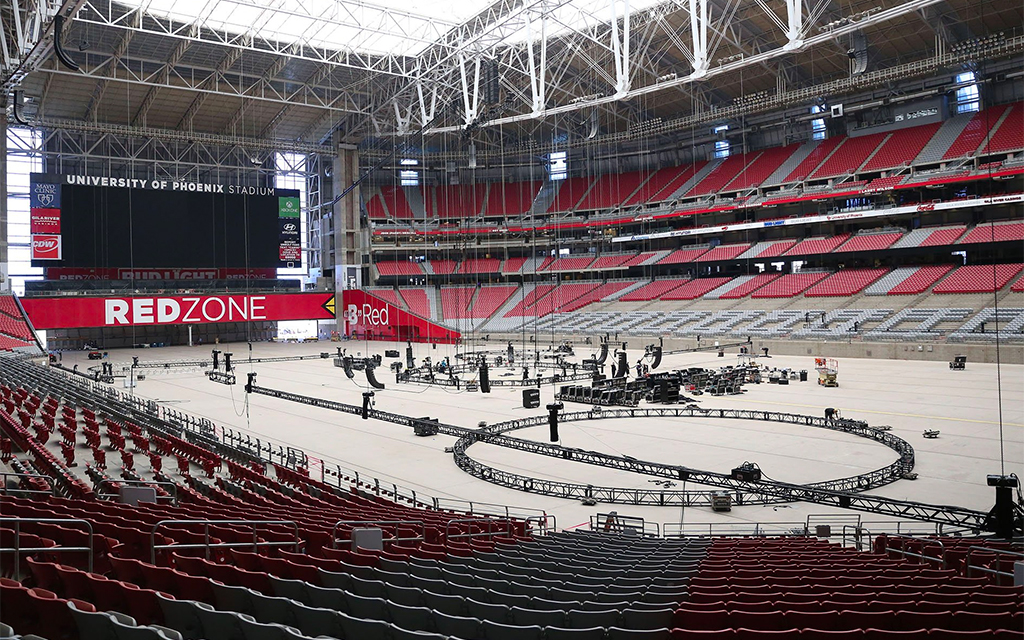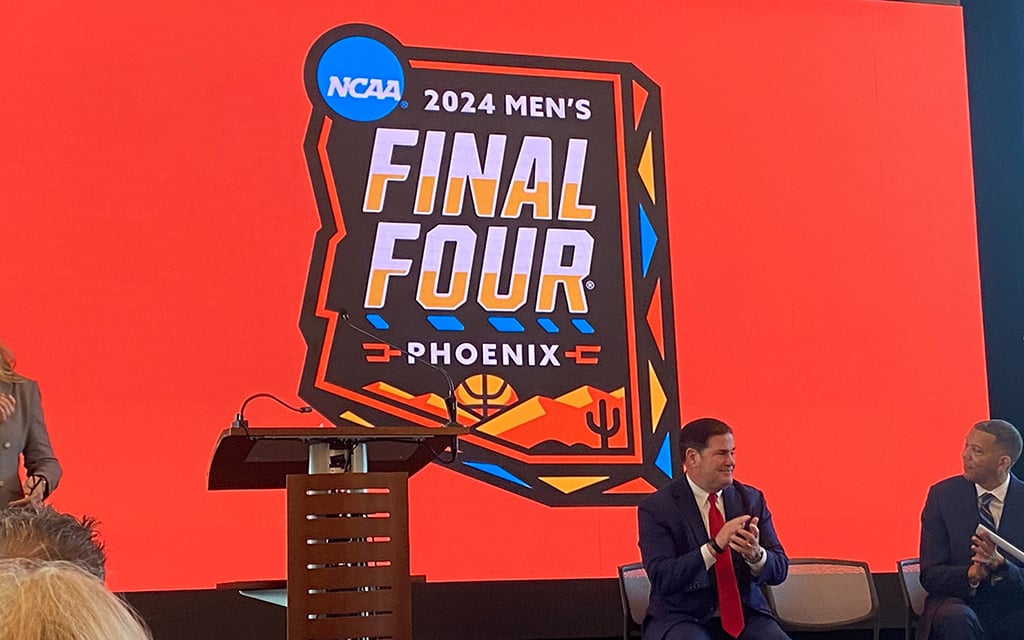TEMPE – Collegiate athletics may be a seasonal scholastic competition, but there is never an offseason for the NCAA.
The same could be said for Arizona State University, which will be the host institution for its third national championship event in a 10-month span by the time the 2024 NCAA Division I Men’s Basketball Final Four is played in April. Two of which – the men’s and women’s golf championships – were hosted in a 13-day stretch starting May 19.
Now Arizona State is preparing to host one of the biggest sporting events in the country: the Final Four. Phoenix will be the only city to host multiple Final Fours since 2017.
“We learned many useful lessons in 2017 and will apply our trademark innovation to provide an unforgettable experience for the NCAA, student-athletes, alumni and fans,” Arizona State vice president for university athletics Ray Anderson said in 2018 after Phoenix secured the 2024 bid.
Getting the bid to host
For the men’s basketball Final Four bidding process, hosts are selected as far as nine years in advance. Arizona State was awarded the bid to host the 2024 Final Four in 2018, but the competitive bidding process took months and required a team effort involving the Phoenix Local Organizing Committee, alongside the Arizona Sports and Tourism Authority, the Arizona Cardinals and a variety of local municipalities.
“The local organizing committees that (we’re) working with do a phenomenal job,” said Arizona State associate athletic director of operations and facilities J.D. Loudabarger.
The national championship host bidders – usually a university, multiple universities or even an athletic conference – have multiple years to plan from the time a bid is submitted to when the event takes place. Different sports have different timelines for announcing how far in advance future tournaments will be played. While sports like men’s and women’s basketball have National Championship locations confirmed through 2030, men’s and women’s soccer don’t have future sites confirmed past 2025.
Arizona State reviewed the sports that made sense to host within the Valley and weighed other factors, including corporate partnerships. Once the university decided upon a sport to bid for, it put a budget together and filed an application that details the facility’s capabilities to host a national championship. The final process includes gathering marketing plans and potential revenue and expenses. And then the fun part: Sending it to the NCAA and hoping to secure the bid.
If a program secures a host bid, it works directly with the NCAA in the years – and in some cases months – before the national championship is held.
“We have meetings all the time to touch base and make sure everybody’s on the same page,” Loudaberger said. “The NCAA was just here (last month) doing some pre-meetings and going through some items and if they have anything that they need us to tweak or change, they give us a heads up, and we can make those adjustments before the championship.”
Many team-based NCAA tournaments have playoff hosts that are determined throughout the season. For example, the first and second rounds of the NCAA Division I women’s basketball tournament are hosted by each of the top four seeds. Halfway through the season, a program will evaluate if they have the potential to host a regional or super regional game and decide whether to place a bid. Unlike hosting a national championship, the process of hosting regional games is scaled down because the games are mostly held at a university facility.
But sometimes, things don’t always go according to plan. For example, South Carolina women’s basketball secured a No. 4 seed in 2019 and was slated to host the regional at its home arena in Columbia, South Carolina. The school could not host at Colonial Life Arena and had to host the Greensboro Regional at UNC Charlotte’s Halton Arena due to the scheduled first and second rounds of the men’s tournament during the same week.
The NCAA Division I Women’s Basketball Committee granted the University of South Carolina a waiver to be able to accommodate the program’s needs.
“Sometimes you have to consider the circumstances,” NCAA Director of Media Coordination and Statistics for the Division I Women’s Basketball Tournament Rick Nixon said. “You definitely want to reward teams for the seasons they’ve had to be able to host, so you try to work with them.”
Nixon works with 19 different hosts in a month for the women’s basketball tournament. Each year, 16 venues host the first two rounds. Two venues host the Sweet 16 and Elite 8, and one venue hosts the Final Four.
“Each place has a different circumstance,” Nixon said. “Some hosts will have a large staff; some will have a small staff; some will have a lot of resources; some will have none. So you’re always trying to balance everything to ensure it all fits and provide the student-athlete experience we all want. So it’s an interesting jigsaw puzzle each year as you go into championships and try to see how it all plays out.”
Planning, planning and more planning
In the women’s basketball model, the top 16 teams host the first and second-round games. Many programs are capable of hosting these games, but it isn’t official until shortly before Selection Sunday.
Host teams have less than a week until the first games of the tournament. Nixon and NCAA Women’s Basketball Committee members have tried to make the process as seamless as possible before the tournament begins.
“We’ve actually started doing videos in and around with the operations manual that you can make evergreen,” Nixon said. “For whatever reason, we didn’t do that so many years ago, but now that’s become part of the everyday exercises is producing different communication pieces that are evergreen that starting in January, early February, that if sites want to start doing their homework, they have to have all the tools to be able to start to do that.”
Men’s and women’s golf are one of the few sports that host its national championships at the same venue. The completion of both tournaments takes approximately two weeks, where some staff members work as many as 17 hours a day.
Hosting two tournaments in a short amount of time can be complex. The landscaping of the course, the firmness of the greens and the pin locations are all things that need to be taken care of in a short amount of time.
Before the NCAA began hosting the men’s and women’s championships at the same venue in 2015, it was seldom that a course would hold a major championship at the same location. In 2014, the Men’s and Women’s U.S. Open was held at the same course, Pinehurst, for the first time in the 128-year history of the prestigious tournament.

Phoenix hosted the NCAA Division I Men’s Basketball Final Four in 2017. North Carolina defeated Gonzaga to win the national championship. (Photo courtesy of Sun Devil Athletics)
“It just takes such a keen attention to detail from everybody involved and we’ve been so fortunate that we have such good partners who did that,” NCAA managing director of championships and alliances John Baldwin said. “The Grayhawk (Golf Course) staff just had it dialed in and did so well with both events that they made it look easier than it was.”
One of the biggest causes for sudden planning of outdoor events is none other than the weather. A field of 156 players for each sport competes in varying lengths of the tournament across tee times that span throughout the entire day. A nearby lightning strike or torrential rainfall could cause delays that impact the tournament.
“There’s not hardly any margin for error in terms of weather,” Baldwin said. “But definitely, with outdoor sports and spring sports and golf in this case, that’s a huge challenge a lot of times … At regionals we had several sites this year on the men’s side that had had lightning delays and other weather delays throughout the regional rounds. It’s something that you just work through and kind of understand that it’s likely going to be a part of it at some point and you work through it the best you can.”
The work of the selection committee
While the host sites do homework on hosting NCAA tournament games, selection committees do homework throughout the entire season on which teams should qualify for the most prestigious tournaments that amateur sports can offer. Roles on an NCAA tournament committee are a service in addition to a full-time job. Many of these committee members are expert ambassadors of the sport. Most consist of individuals currently or formerly employed by athletic institutions or longtime, respected sports media members.
Countless hours are spent discussing the 68 best teams – 36 of whom are selected by the committee as at-large bids – to participate in the most prestigious intercollegiate athletic tournament. Conference calls occur from weeks before the season until postseason competition begins. Committee members frequently use rankings, polls and, most importantly, results to determine the best teams on a weekly basis.
“When you’re on the committee, you have to be in tune with who’s winning each conference and what seed they might deserve, as well as being aware of who might be deserving of an at-large bid,” said former Division I women’s basketball committee chair Rhonda Lundin Bennett. “You’re always watching everybody at the top of each conference, potentially, and teams who would be getting at-large bids because you have to be able to seed all of them.”
Conference monitors provide information to the committee during each committee call to provide information on the performance of teams within that conference. There are 361 teams across 32 Division I conferences, and the conference monitors are tasked with providing information of each school to the committee.
The selection process is never easy despite having more effective algorithms than ever before.
“A team might have all this potential, but if they don’t produce and they don’t get the results and the quality wins they need, they shouldn’t be in the tournament,” Bennett said. “It can’t just be on reputation. So I think having a metric that looks at their results is the way to go.”
Expecting the unexpected
The beauty of NCAA tournaments is anything can happen. So when Loyola Chicago thrust into the spotlight with an improbable run to the 2018 Final Four, there were sure to be storylines to come with it.
Enter Sister Jean, the 98-year-old nun who was the chaplain for the team’s athletic program. During the Ramblers’ run, she became one of the most recognizable faces in U.S. sports, not just the face of Loyola Chicago athletics.
She captured the hearts of hundreds of thousands of fans nationwide with her longtime passion for Ramblers athletics. At the Final Four media availability, she sat in front of a packed media session and took questions as if she were the NCAA Tournament star player.
Unexpected situations like these make the work of David Worlock, the NCAA director of media coordination and statistics for the Division I Men’s Basketball Tournament, all the more unpredictable.
“You have something like that you’re not expecting and now all of a sudden, there are so many requests to speak to Sister Jean that you have to set up a different room into a press conference area and make sure it’s accessible for her,” Worlock said. “It was the most crowded press conference event we’ve had.”
No matter how much planning goes into an event, there’s always one thing that doesn’t go according to plan, and in 2020, a global pandemic was the situation that no one could have ever expected. Arizona State anticipated hosting the NCAA Division I Men’s and Women’s Golf National Championship for the first time from May 22 to June 3 before all NCAA sporting events were canceled in March.
When planning for the national golf championships in 2021, mask mandates were still in effect for outdoor events. But two weeks before the start of the championships, the mask mandate was lifted in Arizona. The NCAA approved lifting the mask mandate for any outdoor event and much of the planning and preparation for months had to be rapidly adjusted.
“We ended up having to change all of our signage two weeks out from the very first championship (in 2021),” Loudabarger said. “All student-athletes had to get tested, which had never happened for golf before. We had special sites at the hotel, bringing in all the supplies and the testing equipment and getting them through that process and cleared before they were allowed to play.”
Although some individuals and teams could not finish the championship because of COVID protocols, golf was still played and champions were crowned.
“Trying to run a championship at the level that it deserves while also trying to follow COVID protocols is something that I certainly hope we never have to do again for many different reasons,” Baldwin said.
Despite an unprecedented situation, the NCAA made necessary modifications to provide the best experience possible for the student-athletes.
Across all sports, NCAA tournaments provide Cinderella stories, raw emotions, memories and moments that will last a lifetime among fans, coaches and athletes alike. Without the work of people determined to provide the best experience to the athlete, the memories that millions have associated with an NCAA tournament would be non-existent.




